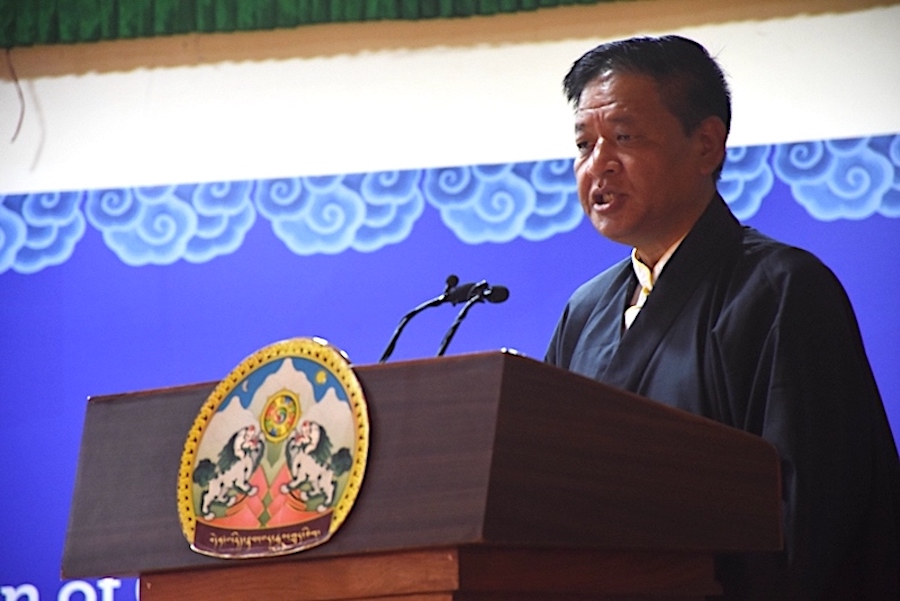PENCIL NOTES
This article is part of a monthly series of socio-political commentary, titled "Pencil Notes". The column is updated in the first week of every month; it will appear in the News section on the first day of its posting, and then move to the Opinion section the following day.
By Tenzin Wangyal
…And out of the houses the rats came tumbling,
Great rats, small rats, lean rats, brawny rats,
Brown rats, black rats, gray rats, tawny rats…
Fathers, mothers, uncles, cousins…
Families by tens and dozens,
Brothers, sisters, husbands, wives —
Followed the Piper for their lives…
– The Pied Piper of Hamelin by Robert Browning
 Most of us know the story of The Pied Piper of Hamelin – in high school, it was one of the poems that I gleefully recited out aloud, reveling in its humor and jingling rhymes. For the benefit of the uninitiated few, but so as not to chagrin the cognizant majority, here’s a pithy summary: it is a folk tale about a strange-looking man who rid the town of Hamelin of its troublesome rats, however, when the townspeople reneged on their promise to pay him, the next time he played his pipe, all the children of Hamelin followed him into a cave, never to be seen again.
Most of us know the story of The Pied Piper of Hamelin – in high school, it was one of the poems that I gleefully recited out aloud, reveling in its humor and jingling rhymes. For the benefit of the uninitiated few, but so as not to chagrin the cognizant majority, here’s a pithy summary: it is a folk tale about a strange-looking man who rid the town of Hamelin of its troublesome rats, however, when the townspeople reneged on their promise to pay him, the next time he played his pipe, all the children of Hamelin followed him into a cave, never to be seen again.
Over the last decade or so, almost every Tibetan presented with the opportunity (myself included) has jumped on the bandwagon and "headed west". In 1990, the U.S. Congress granted immigrant visas to 1,000 Tibetans living in India and Nepal, and today there are around 1,000 Tibetans in Minnesota alone. As for the statistic that there are approximately 7,000 Tibetans living in the U.S. and Canada (according to the Tibetan Demographic Survey of 1998), this figure is just as unreliable as the 6 million that has been cited as the Tibetan population since time immemorial. I personally would not be surprised if I were to be told that there are 7,000 Tibetans in the U.S. alone. Before I go any further, I want to point out that in many respects, the observations I will make regarding the U.S. will also apply for the other western and developed countries to which Tibetans have migrated in the recent years.
When it comes to the U.S., Tibetans can be divided into three groups – there are those Tibetans who are already in the U.S.; then there are those who live outside the U.S.; and there are those Tibetans who are trying everything in their means to come to the U.S. Of the second group, I will be the first to admit that the majority of the older Tibetans living in India and Nepal are least interested in coming to the U.S., and would rather be left in their familiar environs unless it is an independent or genuinely autonomous Tibet that beckons them. I bet there are also a few young idealists, members of a dwindling endangered species, who prefer to not sell out by joining the exodus chanting this familiar mantra as loud as a protest slogan – Om MONEY Padme Hum. But it is the third group of people we ought to be concerned about. In their one-track mind-ed pursuit of a ‘passage’ to the West, they have put their lives on hold, (or on "stand by" mode to use computer jargon), ignoring the opportunities that may be available to them right in front of their eyes.
Before our exile community was bitten by the "Go West" bug, Majnu ka Tilla Tibetan Camp was the transit area for Tibetans heading off to various parts of India or Nepal. Now it has become a transit area for this third group of Tibetans who leave behind the lives they know and go to Majnu ka Tilla much like the starry-eyed young aspiring actors who move to Hollywood with dreams of getting their big break – only a handful making it. And now that the U.S. has tightened its immigration policies, to even say that these young Tibetans are in a transit phase seems to be a euphemism – they are in a state of limbo, with little control over their todays and tomorrows.
Now there is nothing wrong with wanting to come and settle in the West. But the current frenzy and desperation is an affliction that few young Tibetans are immune to and one that could cripple the limbs of our exile community. For some of these young Tibetans, it is not even the allure of the American Dream that is the motivating factor, but rather the irrepressible fear of being left behind as more and more of their friends and neighbors are able to make it across the Atlantic. Their counterpart in the poem would be the lame boy who is unable to keep up with the other "merrily skipping" children and gets left behind, and laments his misfortune.
I do not subscribe to the reductionistic view that Tibetans come to America in droves only for the dollars. I believe that while the Piper plays his tune, even for a group as seemingly homogenous as us Tibetans, each of us hear and are drawn to different notes in the music, depending on our sensitivities, predispositions and priorities being at various stages in our respective lives. These personal reasons can be as noble and selfless as the desire to pull one’s family out of poverty or help one’s relatives, or it can be as shallow as the pursuit of hedonistic materialism and self-aggrandizement. Many older Tibetans have also come to the West fully aware that they are here to lay the foundation, or to pave the way for the next generation of Tibetans, and they readily make the necessary sacrifices so that their children can enjoy all the benefits that come with growing up and living in America. I have also heard of many once-incorrigibly lazy young Tibetans who have rolled up their sleeves after coming to the U.S. and taking advantage of the opportunities here have been of immense help to their families back home. However, while we Tibetans have not drowned like the rats did in the river Weser, on the whole I would venture to say that many of us are having to paddle quite hard to just stay afloat.
Personally, I feel that the young Tibetans who wish to come to the West should equip and prepare themselves accordingly, and look at other mainstream avenues for coming to the West based on their valuable skill-sets, knowledge, and specialization. This way, they will not only be preparing for their future in the West, but also thrive and excel in their chosen professions, not yielding to mental/intellectual stagnation or helplessness in the meantime. It is also important that those bent on coming to the U.S. be careful so that they are not selling their souls in the bargain. In less exaggerated terms, I mean that one should not have to compromise one’s integrity or make concessions at the expense of the collective good. Otherwise, you might find yourself in the West alright, but you will spend the rest of your life scratching your head wondering if you did the right thing and whether it was worth it and so on. It would be like waking up on a kingly bed but with a killer hangover after the last night’s reckless drinking.
Coming back to the poem, when the mayor and the townsfolk reneged on their promise to pay the Piper his due reward, the Piper punished all of them by taking away their children. This is a friendly reminder to myself and to other Tibetans living in the West that if we made a promise to anyone (including ourselves) that we would do something for our nation, our people, or our families once we made it to the West, then it is time we kept our promise, lest the Piper comes along again and plays another tune, this time for grown-ups like you and me.
 Tenzin Wangyal is an alumnus of TCV School, Dharamsala, and Middlebury College, Vermont. He currently works in Boston, USA and is on the Board of Directors for Students for a Free Tibet (SFT). He can be reached at tenzin_wangyal@hotmail.com
Tenzin Wangyal is an alumnus of TCV School, Dharamsala, and Middlebury College, Vermont. He currently works in Boston, USA and is on the Board of Directors for Students for a Free Tibet (SFT). He can be reached at tenzin_wangyal@hotmail.com
DISCLAIMER:
The views expressed (in the article) are solely the views of the author and do not reflect the views of phayul.com or Students for a Free Tibet (SFT) or any other organization or institution that the author is or has been affiliated with, such as his alma mater, Tibetan Children’s Village (TCV) School, Dharamsala.









